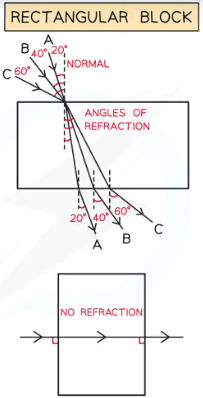Physics IGCSE (Paper 1 ONLY)
1/253
Earn XP
Description and Tags
Name | Mastery | Learn | Test | Matching | Spaced |
|---|
No study sessions yet.
254 Terms
Speed
How fast you’re going with no regard to direction
Velocity
How fast you’re going, but also with the specified direction
Equation: Avg. speed, Distance, Time
v = s/t
Average speed = Distance moved/Time taken
[m/s] = [m]/[s]
![<p>v = s/t</p><p>Average speed = Distance moved/Time taken</p><p>[m/s] = [m]/[s]</p>](https://knowt-user-attachments.s3.amazonaws.com/0dca7f3c-3eba-488b-a5ca-70a8dee1014b.jpeg)
Acceleration
How quickly velocity is changing
Equation: Acceleration, Change in velocity, Time
a = (v-u)/t
Acceleration = (Final velocity - initial velocity) / Time taken
[m/s²] = ([m/s]-[m/s]) / s
![<p>a = (v-u)/t</p><p>Acceleration = (Final velocity - initial velocity) / Time taken</p><p>[m/s<span>²] = ([m/s]-[m/s]) / s</span></p>](https://knowt-user-attachments.s3.amazonaws.com/e8568bfb-21a2-4dea-b817-8781b89f0807.jpeg)
Equation: Final speed, Initial speed, Acceleration, Distance
v² = u² + 2as
(Final velocity)² = (Initial velocity)² + (2 x Acceleration x Distance)
[m/s]² = [m/s]² + 2 x [m/s²] x [m]
![<p>v² = u² + 2as</p><p>(Final velocity)² = (Initial velocity)² + (2 x Acceleration x Distance)</p><p>[m/s]² = [m/s]² + 2 x [m/s²] x [m]</p>](https://knowt-user-attachments.s3.amazonaws.com/ae10702c-60e5-4873-8523-ba771b16a523.jpeg)
Distance-Time Graphs
Gradient at any point = speed of object
Flat section = stopped
Steeper graph = faster speed
Curve = acceleration
Curve getting steeper = speeding up (increasing gradient)
Levelling off curve = slowing down (decreasing gradient)
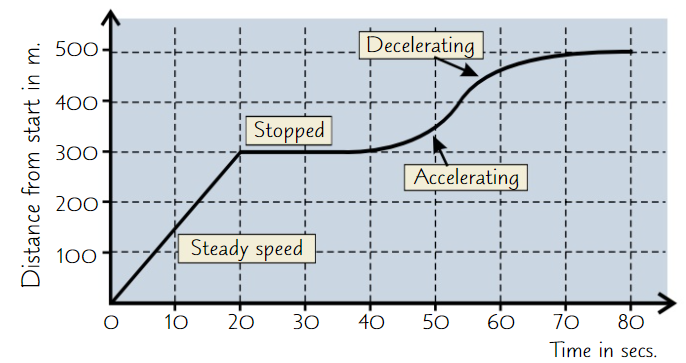
Velocity-Time graphs
Gradient = acceleration
Flat section = steady speed
Steeper graph = greater acceleration/deceleration
Uphill section = acceleration
Downhill section = deceleration
Area under any part of graph = distance travelled in that time interval
Curve = changing acceleration
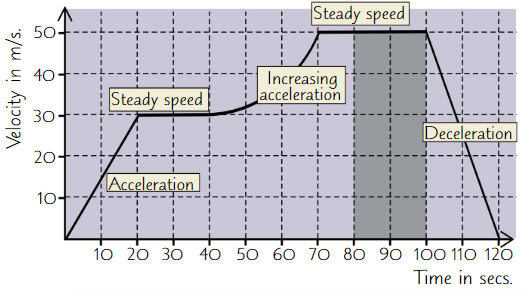
Investigating motion
Set up apparatus as in diagram, holding car still just before light gate
Mark a line on ramp to make sure car starts from same point each time
Measure distance between each light gate - need this to find car’s average speed
Let go of car just before light gate so it starts to roll down slope
Light gates should be connected to computer
When car passes through each light gate, a beam of light is broken and time is recorded by softwareRepeat experiment several times to get average time taken for car to reach each light gate
Use these times and distances to find average speed of car on ramp and average speed of car on runway - divide distance between light gates by average time taken for car to travel between gates

Gravity
Gravity attracts all masses, but only noticeable when one of the masses is very big
This has three effects:
On surface of planet, makes things accelerate towards ground
Gives everything weight
Keeps planets, moons, satellites in orbit
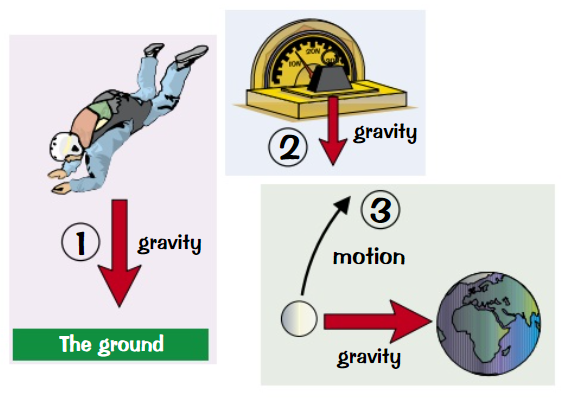
Weight vs Mass
Mass is amount of ‘stuff’ in object - same value anywhere in universe
Weight is caused by pull of gravity
Object has same mass on Earth and Moon - but different weight
1kg mass weighs less on Moon (1.6N) than Earth (10N) because force of gravity pulling on it is less
Weight is force measured in newtons
Mass is not a force
Equation: Weight, Mass, Gravity
W = mg
Weight = Mass x Gravitational field strength
[N] = [kg] / [N/kg]
Force
A push or pull
Vector quantity with size + direction
Gravity/Weight
When close to a planet this acts straight downwards
Reaction force
Acts perpendicular to surface and away from it (if surface is horizontal, reaction force acts straight upwards)
Electrostatic force
Between two charged objects
Direction depends on type of charge (like charges repel, opposites attract)
Thrust
e.g. push or pull due to engine/rocket speeding something up
Drag/air resistance/friction
Slows the object down
Lift
e.g. due to aeroplane wing
Tension
in a rope or cable
Drawing the forces acting on a body
Many forces act on everything, but usually not noticed because they balance out
Any object with weight feels reaction force back from the surface it’s on
Otherwise it would just keep fallingWhen an object moves in fluid (air, water etc.), it feels drag in opposite direction to motion
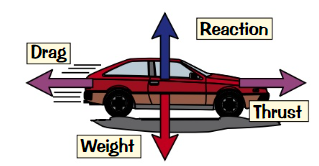
Friction
If an object has no force propelling it, it always slows down and stops due to friction (force that opposes motion)
To travel at steady speed, objects need driving force to counteract friction
Static friction
Friction between solid surfaces which are gripping
Can be reduced by putting lubricant (oil/grease) between surfaces
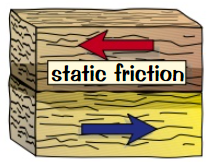
Sliding friction
Can be reduced by putting lubricant (oil/grease) between surfaces
Friction between solids often causes wear of two surfaces in contact
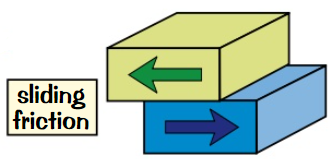
Drag
Keeping shape of object streamlined (sports car, boat hull) reduces drag in fluids
Lorries + caravans have ‘deflectors’ to make them more streamlines + reduce drag
Roof boxes on cars spoil their streamlined shape so slow them down
For a given thrust, higher drag = lower top speed of car
Opposite extreme is parachute (need as high drag as possible)
In fluid, friction always increases as speed increases
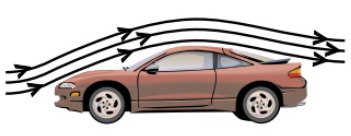
Newton’s First Law of Motion
As long as forces on object are balanced, it will stay still, or if already moving, it carries on at same velocity

Newton’s Second Law of Motion
If there is unbalanced force, object accelerates in that direction
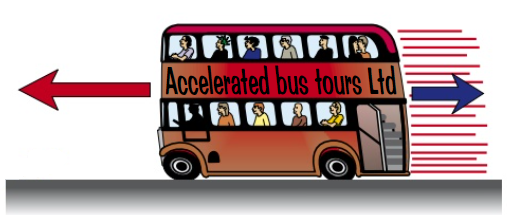
Equation: Force, Mass, Acceleration
F = ma
Force = Mass x Acceleration
[N] = [kg] x [m/s²]
![<p>F = ma</p><p>Force = Mass x Acceleration</p><p>[N] = [kg] x [m/s<span>²]</span></p>](https://knowt-user-attachments.s3.amazonaws.com/5ffe9c76-4010-4315-8495-8f8fc01964cb.jpeg)
Vector quantities
Have size and direction
e.g. force, velocity, acceleration, momentum
Scalar quantities
Only size, no direction
e.g. mass, temperature, time, length
Resultant force
When multiple forces act on object, you can find resultant force acting on object by adding/subtracting - need to know size of all different forces acting on object and their direction
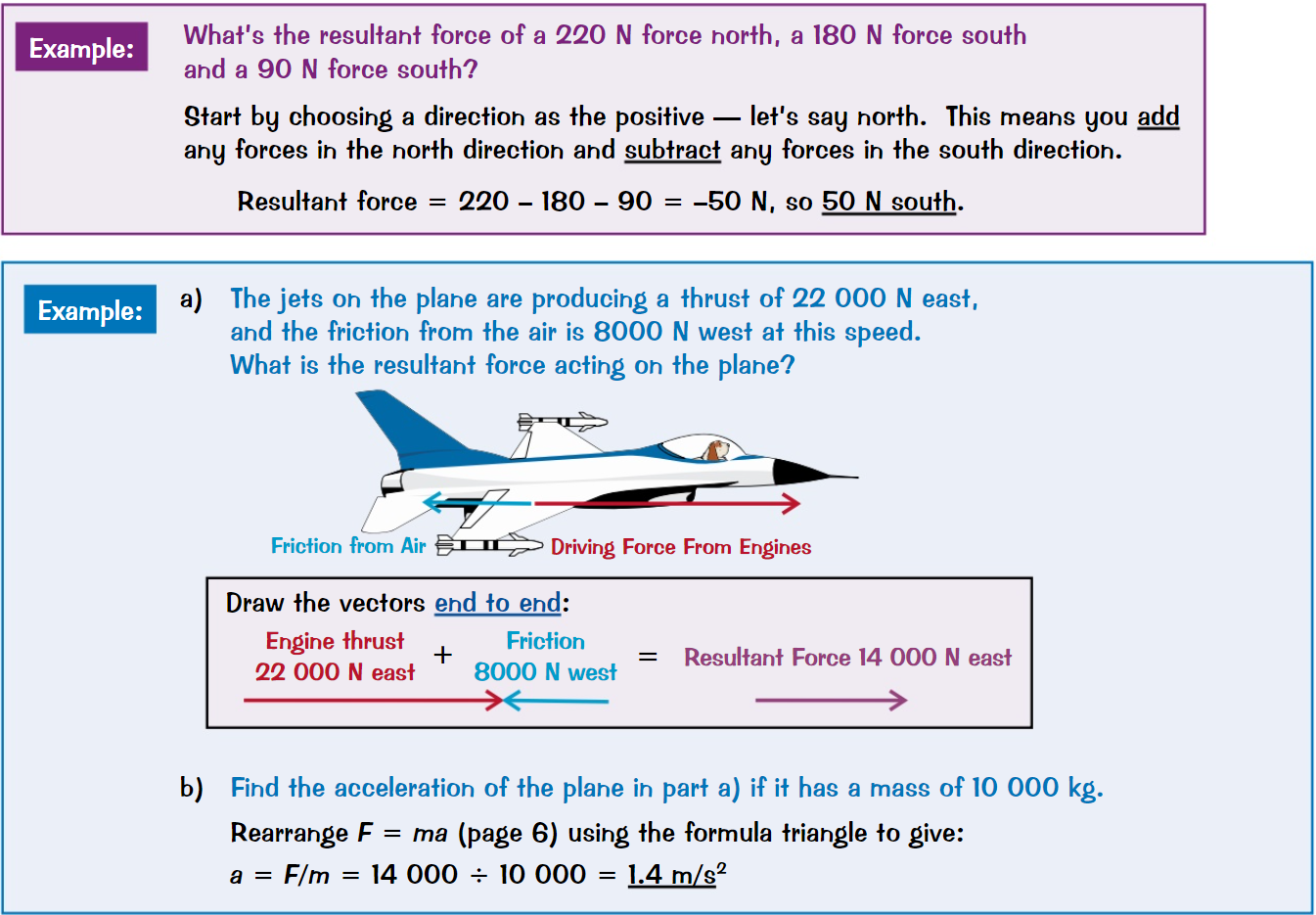
Terminal velocity
Frictional forces increase with speed - but only up to a certain point
When object first starts to fall, it has much more force accelerating it than resistance slowing it down
As velocity increases, resistance builds up
Resistance force gradually reduces acceleration until resistance force is equal to accelerating force
At this point, object can’t accelerate any more, it has reached terminal velocity

Factors affecting terminal velocity
Accelerating force acting on all falling objects is gravity
All objects would accelerate at the same rate without air resistanceAir resistance causes things to fall at diff speeds, and terminal velocity of object is determined by its drag compared to its weight
Drag depends on shape and area
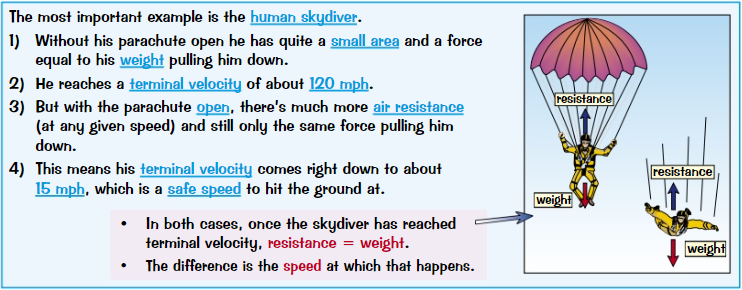
Stopping distance
Distance covered in the time between driver first spotting a hazard and the car coming to complete stop
Stopping Distance = Thinking Distance + Braking Distance
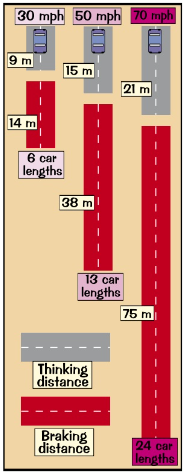
Factors affecting thinking distance
Reaction time - affected by tiredness, drugs, alcohol and old age
Factors affecting braking distance
Speed - faster speed = further distance before stopping
Mass of vehicle - larger mass = longer time to stop
Quality of brakes - worn/faulty brakes increase braking distance
Grip - depends on road surface, weather conditions (e.g. icy), tyres
Equation: Pressure difference
p = h x ρ x g
Pressure difference = Height x Density x Gravitational field strength
[Pa] = [m] x [kg/m³]
Investigating how extension varies with applied force
Set up apparatus as in diagram
Measure length of spring using mm ruler when no load is applied
Ensure ruler is vertical and measure spring at eye level (this is spring’s natural length)Add one mass at a time and allow spring to come to rest, then measure new length of spring
Extension = change in length from original lengthRepeat process until you have enough measurements
Once done, repeat experiment and calculate average value for length of spring for each applied weight
Repat experiment using metal wire or rubber band instead of spring

Hooke’s Law
Extension of stretched wire is proportional to load/force
Metal spring (or other object) also obeys Hooke’s law if a pair of opposite forces are applied to each end
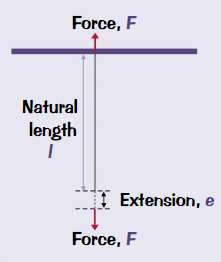
Force-extension graph
There’s a limit to force you can apply for Hooke’s law to stay true
First part of graph shows Hooke’s law being obeyed - straight-line relationship between force and extension
When force becomes great enough, graph starts to curve
If you increase force past elastic limit (marked E on graph), material is permanently stretched
When all force is removed, material will be longer than at the start
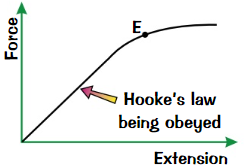
Elastic behaviour
Ability of material to recover to original shape after forces causing deformation have been removed
Electrical conductors
Materials that conduct charge easily - current can flow through
Usually metals e.g. copper + silver
Electrical insulators
Don’t conduct charge very well - current can’t flow
e.g. plastic + rubber
Series circuits
Components connected in a line, end to end, between +ve and -ve of power supply
If you remove/disconnect one component, circuit is broken + all stop working
Not very useful, only a few things are practically connected in series e.g. fairy lights
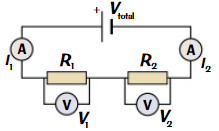
Voltage in series circuit
There’s a bigger supply p.d. when more cells are connected in series
Total p.d. of supply is shared between components
p.d. of each component depends on its resistance
Current in series circuit
Current same everywhere, I₁ = I₂
Size of current depends on total p.d. and total resistance of circuit
Resistance in series circuit
Total resistance of circuit depends on number + type of components
Total resistance is sum of resistance of each component in circuit
Parallel circuits
Each component is separately connected to +ve and -ve of supply
If you remove/disconnect one component, others are hardly affected
This is how most things are connected
e.g. cars and household electrics
Each light switch in your house is part of branch of parallel circuit (turns one light on/off)Everyday circuits often contain mixture of series and parallel parts - rules of series circuits apply to components on same branch
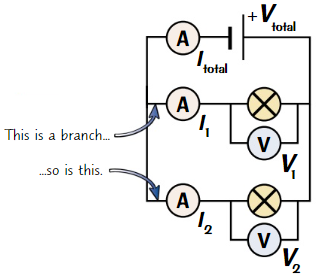
Current in parallel circuit
Current shared between branches
Total current flowing around circuit = total of all currents through separate components
There are junctions where current splits or rejoins
Total current going into junction = total current leaving it
Current through branch depends on resistance, higher resistance = lower current
Voltage in parallel circuit
P.d. is same across all branches, V₁ = V₂
Resistance in parallel circuit
Total resistance of circuit decreases if you add second resistor in parallel
Wire voltage-current characteristics
Current through wire is proportional to voltage
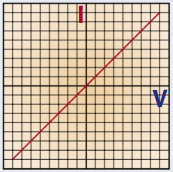
Resistor voltage-current characteristics
Current through resistor is proportional to voltage
Different resistors have different resistances

Metal filament lamp voltage-current characteristics
As temp of metal filament increases, resistance increases
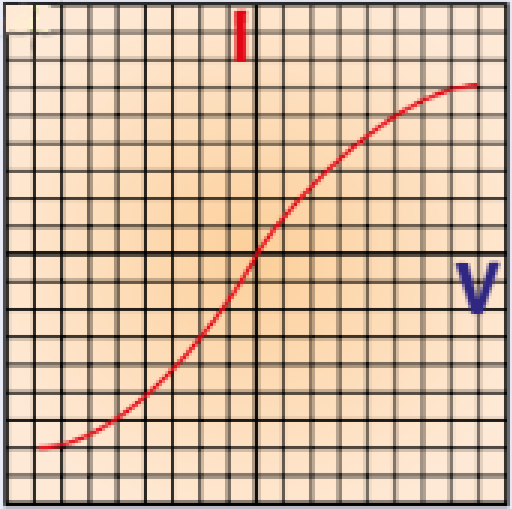
Diode voltage-current characteristics
Current only flows through diode in one direction
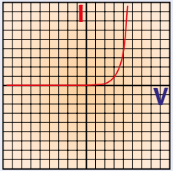
Ammeter
Measures current (in amps) through component
Must be placed in series anywhere in main circuit

Voltmeter
Measures voltage (in volts) across component
Must be placed in parallel around component
Investigating V-I characteristics
Component, ammeter and variable resistor are in series, so can be put in any order
Voltmeter must be placed in parallel around component under test
As you vary variable resistor, it alters current flowing through circuit
Allowing you to take pairs of readings from ammeter and voltmeter
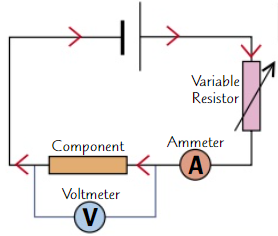
Effect of changing resistance on current
More resistance = less current
LDR
Changes resistance depending on how much light it receives
In bright light, resistance falls
In darkness, resistance is highest
Useful for various electronic circuits e.g. burglar detectors

Thermistor
Temperature-dependent resistor
Hot = resistance drops
Cool = resistance increases
Useful for temperature detectors e.g. car engine temp sensors, thermostats
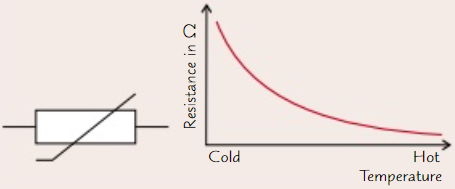
LED
Light-emitting diodes emit light when current flows through them in forward direction
Used for numbers on digital clocks and traffic lights
Unlike light bulb, don’t have filament that can burn out

LEDs and lamps can be used to…
indicate presence of current in circuit
Often used in appliances to show they’re switched on
Equation: Voltage, Current and Resistance
V = IR
Voltage = Current x Resistance
[V] = [A] x [Ω]
![<p>V = IR</p><p>Voltage = Current x Resistance</p><p>[V] = [A] x [<span>Ω</span>]</p>](https://knowt-user-attachments.s3.amazonaws.com/8d3e5016-7bdf-45be-a3be-74364c696460.jpeg)
Current
Rate of flow of charge around a circuit
Equation: Charge, Current and Time
Q = It
Charge = Current x Time
[C] = [I] x [s]
In solid metal conductors, current is…
a flow of negatively charged electrons
Plugs
Have three wires - live, neutral, earth
Only live and neutral wires usually needed, but earth wire stops you getting hurt if something goes wrong
LIVE WIRE alternates between HIGH +VE AND -VE VOLTAGE of 230V
NEUTRAL WIRE always at 0V
Electricity normally flows in through live and neutral wire
EARTH WIRE and fuse are just for safety
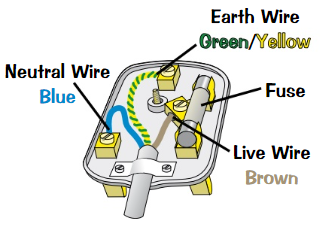
Double insulation
If appliance has plastic casing and no metal parts showing, it’s said to be double insulated
Plastic is insulator, so stops current flowing - meaning you can’t get a shock
Anything with double insulation doesn’t need earth wire
Earthing and fuses
If fault develops in which live touches metal case, then because case is earthed, big current flows through live wire, case and earth wire
Surge in current melts the fuse, cutting off the live supply
This isolates the whole appliance, making it impossible to get electric shock from case
Also prevents risk of fire caused by heating effect of large current
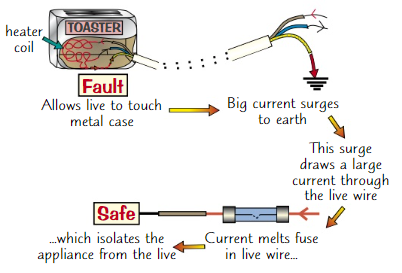
Circuit breakers
Protect circuit from damage if too much current flows
When circuit breakers detect surge in current, they break circuit by opening a switch
Circuit breaker can easily be reset by flicking a switch on the device
This makes them more convenient than fuses (have to be replaced once melted)
Heating effect in resistors
When there is electrical current in resistor, there is energy transfer which heats resistor
Because electrons collide with ions in lattice that make up resistor as they flow through it
This gives ions energy, causing them to vibrate and heat up
Heating effect increases resistor’s resistance - so less current flows
Heating effect can cause components in circuit to melt - so circuit stops working
Use of heating effect in resistors
Toasters contain coil of wire with very high resistance
When current passes through coil, temp increases so much that it glows and emits IR (heat) radiation which cooks bread
Equation: Power, Current and Voltage
P = IV
Power = Current x Voltage
[W] = [A] x [V]
Fuse ratings
Fuses have current ratings and should be rated as near as possible but just higher than the normal operating current
To work out the fuse needed, you need to work out the current that item normally uses

Equation: Energy, Current, Voltage and Time
E = IVt
Energy transferred = Current x Voltage x Time
[J] = [A] x [V] x [s]
Alternating current (a.c.)
Current is constantly changing direction
Used for mains supply, e.g. UK mains supply is approx. 230V
Direct current (d.c.)
Current keeps flowing in same direction
Used in cells and batteries
Voltage
Energy transferred per unit charge passed
One volt = one joule per coulomb
Equation: Energy, Charge and Voltage
E = QV
Energy transferred = Charge x Voltage
[J] = [C] x [V]
Longitudinal wave
Vibrations are along same direction as energy transfer

Transverse wave
Vibrations are perpendicular (at 90ᵒ) to direction of energy transfer

Amplitude
Height of wave (from rest to crest)

Frequency (f)
Number of complete waves per second (passing a certain point)
Measured in hertz (Hz)
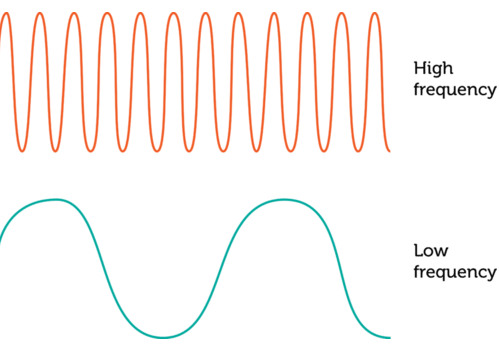
Wavelength (λ)
Distance from one peak to the next
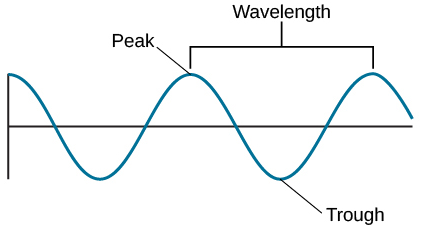
Period of wave (T)
Time taken (in s) for one complete wave to pass a point
Wavefront
Imaginary planes that cut across multiple waves, connecting points on adjacent waves which are vibrating together
Distance between each wavefront = one wavelength

Waves transfer…
energy and info without transferring matter
e.g. microwaves in an oven make things warm up - energy transferred to food you’re cooking
Waves can be used as signals to transfer info from one place to another
e.g. radio waves travelling through air
Equation: Wave speed, frequency and wavelength
v = fλ
Wave speed = Frequency x Wavelength
[m/s] = [Hz] x [m]
Equation: Frequency, Time period
f = 1/T
Frequency = 1/time
[Hz] = 1/[s]
Doppler effect
Waves produced by source which is moving towards/away from observer have diff wavelength than they would if source was stationary
Because wave speed is constant, so if source is moving, it ‘catches up’ to waves in front
Causes wavefronts to bunch up in front of moving source and spread out behind itFrequency of wave from source moving towards you is higher and wavelength shorter than wave produced by source
Frequency of wave from source moving away from you is lower and wavelength longer than wave produced by source

All waves can be…
reflected and refracted
Sound waves
Longitudinal waves caused by vibrating objects
Light waves are…
transverse waves
that can be reflected and refracted
Law of reflection
Angle of incidence = Angle of reflection
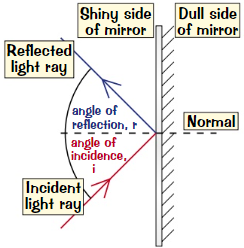
Ray diagrams for reflected waves

Refraction
Waves travel at different speeds in substances with different densities
Sound waves travel faster in denser substances
When a wave crosses a boundary between two substances (e.g. glass to air), it changes speed

Ray diagrams for refracted waves
Show the path that a wave travels
Draw boundary between two materials and the normal (a line perpendicular to boundary)
Draw incident ray that meets normal at boundary
Angle between ray and normal = angle of incidence
Draw refracted ray on other side of boundary
If second material is denser than first, refracted ray bends towards normal
Angle between refracted ray and normal (angle of refraction) is smaller than angle of incidenceIf second material is less dense, angle of refraction is larger than angle of incidence
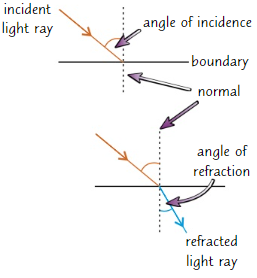
Investigating refraction
Place glass block on piece of paper, and carefully draw around rectangular perspex block using pencil
Switch on ray box and direct beam of light at side face of block
Mark on paper:
Point on ray close to ray box
Point where ray enters block
Point where ray exits block
Point on exit light ray which is 5cm away from block
Draw dashed line normal (at right angles) to outline of block where points are
Remove block and join points marked with 3 straight lines
Replace block within its outline and repeat process for ray striking block at different angle
Repeat procedure for each shape of perspex block (semi-circular and prism)
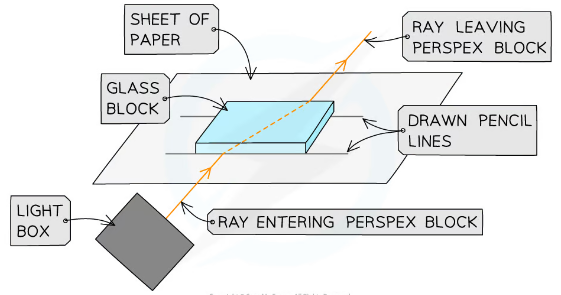
Rectangular block
